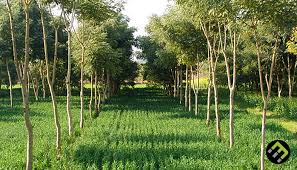Agroforestry

Agroforestry is a land use management system in which trees or shrubs are grown around or among crops or pastureland. This diversification of the farming system initiates an agroecological succession, like that in natural ecosystems, and so starts a chain of events that enhance the functionality and sustainability of the farming system. Trees also produce a wide range of useful and marketable products from fruits/nuts, medicines, wood products, etc. This intentional combination of agriculture and forestry has multiple benefits, such as greatly enhanced yields from staple food crops, enhanced farmer livelihoods from income generation, increased biodiversity, improved soil structure and health, reduced erosion, and carbon sequestration. Agroforestry practices are highly beneficial in the tropics, especially in subsistence smallholdings in sub-Saharan Africa and have been found to be beneficial in Europe and the United States.
Agroforestry shares principles with intercropping but can also involve much more complex multi-strata agroforests containing hundreds of species. Agroforestry can also utilise nitrogen-fixing plants such as legumes to restore soil nitrogen fertility. The nitrogen-fixing plants can be planted either sequentially or simultaneously.

Benefits of Agro forestry
- They can control runoff and soil erosion, thereby reducing losses of water, soil material, organic matter and nutrients.
- They can maintain soil organic matter and biological activity at levels satisfactory for soil fertility. This depends on an adequate proportion of trees in the system- normally at least 20% crown cover of trees to maintain organic matter over systems as a whole.
- They can maintain more favourable soil physical properties than agriculture, through organic matter maintenance and the effects of tree roots.
- They can lead to more closed nutrient cycling than agriculture and hence to more efficient use of nutrients. This is true to an impressive degree for forest garden/farming systems.
- They can check the development of soil toxicities, or reduce exiting toxicities-both soil acidification and salinization can be checked and trees can be employed in the reclamation of polluted soils.
- They utilize solar energy more efficiently than monocultural systems different height plants, leaf shapes and alignments all contribute.
- They can lead to reduced insect pests and associated diseases.
- They can be employed to reclaim eroded and degraded land.
- Agro forestry can augment soil water availability to land use systems. In dry regions, though, competition between trees and crops is a major problem.
- Nitrogen-fixing trees and shrubs can substantially increase nitrogen inputs to agro forestry systems.
- Trees can probably increase nutrient inputs to agro forestry systems by retrieval from lower soil horizons and weathering rock.
- The decomposition of tree and pruning can substantially contribute to maintenance of soil fertility. The addition of high-quality tree prunings leads to large increase in crop yields.
- The release of nutrients from the decomposition of tree residues can be synchronized with the requirements for nutrient uptake of associated crops. While different trees and crops will all have different requirement, and there will always be some imbalance, the addition of high quality prunings to the soil at the time of crop planting usually leads to a good degree of synchrony between nutrient release and demand.
- In the maintenance of soil fertility under agro forestry, the role of roots is at least as important as that of above-ground biomass.
- Agro forestry can provide a more diverse farm economy and stimulate the whole rural economy, leading to more stable farms and communities. Economics risks are reduced when systems produce multiple products.

According to the Central Queensland Forest Association agroforestry can improve land protection in the following areas:
Salinity and water table control:
Salinity is mainly caused by rising water tables. Trees help to lower water tables, acting as pumps to take up water from the soil and then evaporating it to the atmosphere.
Soil erosion control:
Soil erosion or loss results from the action of wind and water on unprotected soils. The forest canopy, roots and leaf litter all have a role in controlling soil erosion.
Water logging:
Through water removal, established trees can substantially reduce water logging in their immediate area, which may result in improved land uses, e.g. pasture or crop.
Source:
https://en.reset.org/knowledge/agroforestry-and-its-benefits
https://en.m.wikipedia.org/wiki/Agroforestry
